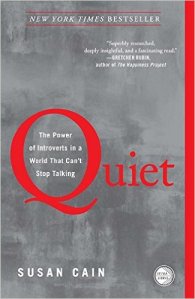5.) Eye contact: Train yourself to be aware of eye contact. Eye contact doesn’t come naturally for an introvert. It’s common to not only avert one’s gaze, but to zone out in the process because one’s mind is trying to anticipate the direction of the conversation and formulate a replies. There’s not enough consciousness left for monitoring the visual stream. This has a number of side-effects such as:
-missing non-verbal cues
-appearing uninterested
-staring in the wrong direction (crotches, cleavage, Hells Angels, etc.)
Just don’t let the pendulum swing too far such that one stares like a homicidal maniac.
4.) Scheduling: Bracket social and /or noisy events with quiet time. It’s not just social activity that can be draining for the introvert, being in environments with high levels of sensory stimulation will run down one’s energy even if one isn’t interacting socially. Living in India, I find that sometimes just walking down the street and minding my own business wears fairly rapidly. In moderated doses, these sensory-intensive situations are enjoyable and beneficial, but the secret is to avoid redlining. Extended periods of high stimulation may result in you being grumpy and / or dull.
3.) Readings: Come on, you’re an introvert, you know you love reading. There are a number of books that have come out in recent years to help introverts both better understand introversion and to learn to arrange their lives in a manner optimized to it. I’ll mention two of the more well-known ones.
The first is The Introvert Advantage by Marti Olsen Laney. I mention this one first because it was the first book I read on the subject, and it transformed my thinking about what it meant to be introverted. Though I’m an introvert, I didn’t really understand introvertism until I read Laney’s work.
The more well-known and critically acclaimed book, however, is Quiet by Susan Cain.
2.) Introversion ≠ Shyness: Know the difference between introversion and shyness (social anxiety.) Introversion has long been considered synonymous with shyness. Even many psychologists and mental health professionals seem to believe they are one in the same–or at least they did until the recent spate of books, TED Talks, etc. It’s true that many people are both shy and introverted, but it’s more complicated than that. One can be extroverted and shy. Talk about a raw deal. The shy introvert faces forces pulling them in one direction. The shy extrovert is being pulled in two different directions at once.
1.) Embrace it: Accept your introverted nature. Given an extrovert bias, there’s a proclivity for introverts to wish they were extroverted or to even try to force themselves to be so. This is a recipe for disaster. I discussed the difference between introversion and shyness above, shyness is something that one can work on reducing through visualization, mindfulness, and–most importantly–practice interacting, but introversion is hardwired.




Eye contact. Good Lord. But I’ll try
LikeLike
One starts small. I have the advantage of living now in India where there is probably the lowest social norm against staring of anywhere I’ve ever been in the world. Since I’m a foreigner I get stared at intensely, so I’ve not felt as awkward returning the eye contact. In most places in the world, if one returns eye contact the other person will look away. Here I would say maybe 60% will look away, but for the rest it could become a staring contest if you let it.
LikeLike
cool
LikeLike
“One can be extroverted and shy.” Tell me about it! Needing the approval of others yet finding it difficult to initiate contact and then fearing possible rejection. At least life isn’t dull.
LikeLike
Yes. That was one of the biggest ideas that I learned from Laney’s book. I used to be both introverted and shy, I’ve become less of the latter and more aware of / able to manage the former. Insights into anxiety from yoga have played a big part.
LikeLiked by 1 person
much needed 🙏🏻
LikeLike